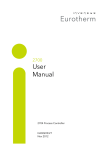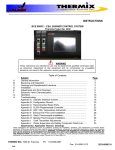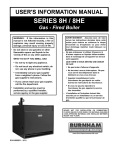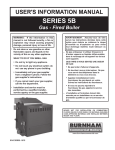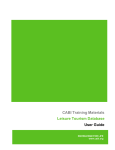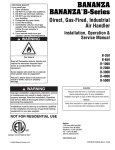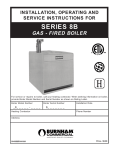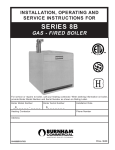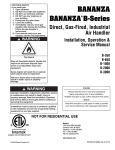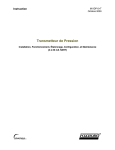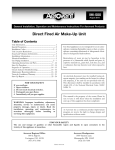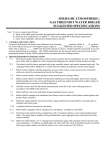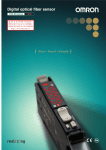Download BCS 6000B BURNER CONTROL SYSTEM
Transcript
INSTRUCTIONS BCS 6000B BURNER CONTROL SYSTEM Section Table of Contents Page A. General Information 2 B. Receiving and Inspection 2 C. Drawings and Supplemental Literature 3 D. Installation 3 E. Adjustments and Final Checkout 5 F. Electronic Valve Characterization 8 G. Operation 9 H. Troubleshooting 11 Appendix A Operator Interface Screens 14 Appendix B Configuration Record 18 Appendix C Recommended Spare Parts 19 Appendix D DL250 Programmable Controller 20 Appendix E UDC 1000 Temperature Instrument 22 Appendix F Exhaust Fan Flow Limit Installation 24 Appendix G Stack Thermocouple Installation 25 Appendix H Material Thermocouple Installation 26 Appendix I Draft Transmitter Adjustments 28 Attachments: Applicable Hauck Drawings These instructions are intended to serve as guidelines covering the installation, operation, and maintenance of Hauck equipment. While every attempt has been made to ensure completeness, unforeseen or unspecified applications, details, and variations may preclude covering every possible contingency. WARNING: TO PREVENT THE POSSIBILITY OF SERIOUS BODILY INJURY, DO NOT USE OR OPERATE ANY EQUIPMENT OR COMPONENT WITH ANY PARTS REMOVED OR ANY PARTS NOT APPROVED BY THE MANUFACTURER. Should further information be required or desired or should particular problems arise which are not covered sufficiently for the purchaser's purpose, contact Hauck Mfg. Co. HAUCK MANUFACTURING CO., P.O. Box 90, Lebanon, PA 17042-0090 717-272-3051 Fax: 717-273-9882 4/03 www.hauckburner.com BCS-6000B-9 Page 2 BCS6000B-9 A. GENERAL INFORMATION The Hauck Burner Control System (BCS) provides burner management and temperature control for a single, pilot ignited burner firing on natural gas or oil. The spark ignited, gas fired pilot is interrupted after the main burner flame has been established. Flame supervision is provided by a Honeywell RM7890A1015 flame relay combined with a R7849A1023 amplifier module and C7027A UV detector(s). This panel includes special provisions for adjustable valve characterization in order to reduce stack emissions. Reference section F. VALVE CHARACTERIZATION for details A Programmable Logic Controller (PLC) supervises burner operation and provides three process control loops for material temperature, stack temperature, dryer draft. The PLC is coupled to a touchscreen display to supply the operator with system status and fault annunciation. Two Honeywell UDC1000 series instruments are provided for temperature indication and overtemperature protection. The thermocouple of the MATERIAL CONTROL instrument is positioned to read the temperature of the material as it exits the dryer while the STACK TEMPERATURE instrument’s thermocouple senses the temperature of the exhaust gases. The UDC1000 instruments display the process temperature and provide temperature inputs to the Programmable Logic Controller. The PLC, in turn, is electronically linked to the burner control motors to automatically adjust the burner firing rate and maintain process temperature near setpoint. The Operator can assign control of the burner to either thermocouple. The alarm contact of the STACK TEMPERATURE instrument is used to shut down the burner if the preset high temperature limit is exceeded. The PLC also provides a high stack and material temperature alarms, which drive the burner to low fire if the alarm setpoints are exceeded.. CAUTION The STACK alarm setpoint is factory set at 400 °F (204 C). If the system is equipped with a fabric dust collector (baghouse), consult the manufacturer for recommended baghouse temperature limitations. Refer to Appendix E for entering the desired alarm setpoints B. RECEIVING AND INSPECTION Upon receipt, check each item on the bill of lading and/or invoice to determine that all equipment has been received. Examine all parts to determine if there has been any damage in shipment. If equipment is to be stored prior to installation, provide a dry storage area. IMPORTANT For optimum use of the BCS panel, it is suggested that the drawings provided by Hauck be referred to for limit switch and valve installation and wiring. In the event that a recommended switch or valve is not used, it may be necessary to connect jumper wire(s) between appropriate terminals in the control panel or burner junction box. Such determination remains the responsibility of the Customer, based upon his application, accepted safe installation and operating procedures, and any applicable insurance guidelines or governmental regulations. Page 3 BCS6000B-9 C. DRAWINGS AND SUPPLEMENTAL DATA Tabletop Panel Assy. Drop-in Panel Assy. Wiring Diagram System Schematic External Component Wiring StarJet CY7320 CY7321 CY7316 CY7345 CY7319 BURNER SYSTEM Eco-Star CY7320 CY7321 CY7316 CY7345 CY7317 Eco-StarII CY7320 CY7321 CY7316 CY7315 CY7318 D. INSTALLATION 1. Locate the tabletop panel on a firm support in an area that is protected from the weather and free from vibration. The drop-in version is designed to install in an existing enclosure. Reference drawing CY7321 for required cutouts and mounting dimensions. IMPORTANT Operating specifications of 32 to 131 °F (0 to 55 °C), 30 to 95% relative humidity (non-condensing) should be considered in selecting a suitable location for the control panel. 2. Provide 120Vac single-phase grounded neutral power to the burner control panel. It is recommended that the Customer provide a master disconnect switch to interrupt power service to the panel. Maintain polarity as indicated on the drawings provided when connecting the main power source to the panel. 3. Install a heavy gauge (No. 12 AWG minimum) ground wire between the panel ground connector and "Earth" ground. 4. Wire the fuel valves, valve position limit switches and fuel pressure limit switches as shown on the external component wiring diagram. 5. Install the exhaust fan flow limit switch in the dryer exhaust duct as shown in Appendix F. Wire the normally open contact of the exhaust flow limit to the appropriate terminals in either the burner junction box or the BCS control panel. 6. Install the stack temperature thermocouple in the dryer exhaust duct to sense exhaust gas temperature. See Appendix G. for installation instructions. 7. Install a Hauck Rapid Response material temperature thermocouple in the material discharge chute to sense the temperature of the material leaving the dryer. See Appendix H. for recommended installation. 8. Connect the thermocouples to the appropriate terminals in the BCS control panel using thermocouple cable of the same type as the Material and Stack thermocouples. Page 4 BCS6000B-9 IMPORTANT Thermocouple cables must be separated from AC power and control wiring to avoid interference and nuisance shutdowns. Observe polarity when making thermocouple connections. Regardless of thermocouple type, the red wire is always negative. 9. A pressure tap for the dryer draft transmitter should be located in the 10 o’clock or 2 o’clock position on the dryer breech. Locate the tap midway between the outer edge of the breeching and the outer edge of the combustion chamber or shell. Cut a hole to accommodate a 1” pipe coupling angled downward approximately 30 degrees. 10. Mount the draft transmitter on a vibration free support, shielded from direct flame radiation. The operating temperature range is -20 to 180°F. Connect the transmitter manifold to the LOW pressure tap and leave the HIGH tap open to atmosphere as a reference. The open tap must be shielded from wind and other disturbances and should not be in a position to collect dirt or water. The manifold moisture drain should be positioned vertically down. 11. Install the flame scanner(s) on the burner and wire them to the appropriate terminals in the burner junction box. Reference burner instructions for scanner installation details. 12. Refer to the external component wiring diagram for interconnection between the burner junction box and the BCS panel terminal strips. IMPORTANT The flame scanner, draft transmitter, and control motor position feedback signals should be run in a separate harness from the burner junction box to the BCS control panel. These cables may be run along with thermocouple cables but must be separated from all other AC power and control wiring. Note that if shielded cable is used, only one end of the cable shield should be grounded. Use one of the ground terminals in the BCS control panel for this purpose. 13. Set the purge timer, 1TR, for the required purge time. IMPORTANT Before igniting the burner, the dryer must be purged to remove possible accumulation of combustible gases. A MINIMUM OF FOUR COMPLETE AIR CHANGES MUST BE SUPPLIED. Multiply the total system volume (dryer, baghouse and exhaust ducts) in cubic feet by four. Divide this value by the burner air capacity in cubic feet per minute. The result will be the required purge time in minutes. 14. Be sure that all equipment and components have been installed in accordance with the manufacturer's instructions. 15. Verify all wiring and tighten connections. 16. Clean all traps and filters. 17. Check all fuel and air supply lines for leaks. 18. Verify all pressure settings. Page 5 BCS6000B-9 E. ADJUSTMENTS and FINAL CHECKOUT: Record all settings on the CONFIGURATION RECORD SHEET provided in Appendix B. IMPORTANT The burner control motors incorporate a position feedback slidewire. A 5 Vdc supply voltage from the panel is connected to the slidewires in order to generate 0 to 5 Vdc position feedback signals for the PLC. The following control motor calibration procedure must be performed before operating the burner for the first time. RECALIBRATE ANNUALLY OR WHENEVER A CONTROL MOTOR IS SERVICED OR REPLACED. The EZ-S8C-F touchscreen provides access to the system operating parameters. Note that touching any of the numeric displays with white text on a blue background will provide a pop-up keypad for numeric entry. The use of a pencil eraser, wooden or plastic stylus is recommended for more precise selection. In order to extend the life of the display, it has been programmed to enter a screen saver mode 5 minutes after the burner is stopped. Simply touch the display to de-activate the screen saver. MOTOR CALIBRATION & SETUP Screen Press the MAIN MENU key to access the menu screen then press the MOTOR CALIBRATION & SETUP button to display the calibration screen. MOTOR CALIBRATION The control motor DEADBAND settings determine the allowable deviation of actual control motor position from setpoint without corrective action by the motor control outputs (minimum 0.5%, maximum 5.0%, typically set at 1.0% for fuel and 1.5% for air). These parameters should be set as low as possible without causing the control motors to "hunt" excessively. Touch the numeric displays and use the popup keypad to enter a deadband setting for each motor. Press the ZERO button to drive all control motors closed for calibration and record the slidewire feedback signals. Confirm that all motors have reached their low fire positions before beginning span calibration. Press the SPAN button to drive the motors open and record the resulting feedback signals. Verify that all motors have fully opened before pressing the OFF button to store the span values and end motor calibration. BURNER OPERATING PARAMETERS Set the BURNER OUTPUT LIMIT at 100.0% for normal operation. This value may need to be lowered to accommodate system limitations. If the optional gas flow display and totalizer is installed, set the GAS PRESSURE to match the pressure, in ounces, measured just upstream of the gas orifice flange assembly. TEMPERATURE DISPLAY If the Material and Stack temperatures displayed on the touchscreen are significantly different from the UDC1000 instrument displays, a positive or negative BIAS value may be entered for each instrument. Page 6 BCS6000B-9 CONTROL LOOP TUNING Screen After setting and recording all parameters on the motor calibration & setup screen, press MAIN MENU key to return to the menu screen then select the CONTROL LOOP TUNING button to display the loop tuning screen. This screen is used to enter tuning constants for each of the three PID control loops. MATERIAL or STACK temperature control may be selected on this screen. Manual control of the burner firing rate and exhaust damper control motors is also provided. Enter a GAIN setting for each loop. Note that Gain = 100/Proportional Band% or Proportional Band% = 100/Gain. For example a Gain of 5 is equivalent to a Proportional Band setting of 20% Enter a DEADBAND setting (degrees F for temperature and inches of water column for draft) for each loop. This value should be as small as possible without excessive “hunting” by the control actuators. Enter a RESET setting for the Material and Stack control loops. Note that Reset is expressed in minutes per repeat rather than repeats per minute. Therefore, the smaller the setting the more frequently reset action will be repeated. Enter a RATE setting (seconds) if desired for Material and Stack control. Note that Rate tends to de-stabilize the control and may be left at zero. Enter CYCLE time settings (seconds) for the Draft control loop. Note that this loop provides duplex time proportional control outputs for the exhaust damper actuator and has separate Open and Close cycle times similar to the DPS instrument it replaces. AUTOTUNE The Material, Stack and Draft control PID loops are equipped with an AUTO TUNE button. Please note the following before initiating the auto tune procedure: The process should be stabilized and operating under normal conditions before beginning the auto tune procedure. Do not change material feed rate, mix or setpoint while auto tune is in progress. Only one loop at a time may be tuned. The loop must be in AUTO. The loop will be cycled between 100% and 0% three times during the course of the auto tune procedure. Obviously, this will cause significant swings in temperature and/or dryer draft. Auto tune may be interrupted, if necessary, by placing the control loop in manual. The resulting GAIN, RESET and RATE parameters (GAIN only for draft control) will be automatically updated when the sequence is completed. RUN MENU Screen After all loop tuning settings have been recorded return to the MAIN MENU then press RUN MENU to display the run menu screen. This screen provides control mode selection, startup ramp settings for automatic temperature control, low fire drive alarm settings, and draft control setpoints. Page 7 BCS6000B-9 DRAFT CONTROL Enter a draft control PURGE SETPOINT for use during the burner purge sequence. Set this value higher than the normal draft setpoint to prevent dusting as the air damper drives open for purge. Enter LOW FIRE and HIGH FIRE SETPOINTS for draft control. The draft setpoint will automatically ramp from the low fire to the high fire setpoint as the burner firing rate increases. Enter a TRANSFER DELAY time in seconds to set the length of time after burner ignition is initiated that the purge setpoint remains active for draft control before transferring to the normal operating setpoint. To accommodate variations in material moisture or composition and prevent nuisance shutdowns, provisions are made for automatic draft setpoint increase. The PLC senses “puffs” in the dryer drum and automatically increases dryer draft if a set number of puffs occurs within a ten second time window. Set the desired increase via the INCREASE DRAFT BY _.__”WC display and enter values in the IF DRAFT DROPS BELOW _.__”WC and MORE THAN __ TIMES fields. For example, with settings of 0.02”WC, 0.10”WC and 2 Times, the dryer draft setpoint would be increased by 0.02”WC if dryer draft dropped below 0.10”WC more than 2 times within a 10 second interval due to puffing. Note that the draft control setpoint returns to its original setting when the burner is shut off. TEMPERATURE CONTROL Select MATERIAL or STACK temperature control. Set a START AT and RAMP AT percentage for startup. If automatic temperature control is selected, the burner will drive to the START AT __% setting as soon as the main flame has been established. The control output will then begin to RAMP AT __% per minute until the output of the selected temperature control loop is equal to or less than the ramp output. The control loop will then assume control of the burner firing rate. The burner will be forced to low fire if the stack temperature exceeds the LOW FIRE DRIVE IF STACK GREATER THAN __ F. setting. Likewise, the burner will be forced to low fire if material temperature exceeds the LOW FIRE DRIVE IF MATERIAL GREATER THAN __ F. setting. LINKAGE SETUP After motor calibration is completed and system setup parameters have been set, press the LINKAGE SETUP button to enter the linkage setup mode. The fuel and air control motors will be released from low fire and respond to the output of the temperature control loop. Return to the MAIN screen and place the temperature control loop in MANUAL. Drive the motors as required to adjust fuel and air control valve linkages. Confirm all linkage adjustments and insure that control arms and linkage rods are tight, then return to the RUN MENU screen and select either MATERIAL or STACK control to return to normal operation. Verify that all low fire limit switch contacts are closed (Slot 2, input 5) is ON when the burner is at 0% and OFF when the burner leaves low fire. Refer to the burner operating instructions for switch adjustment. Page 8 BCS6000B-9 Time and Date Setting Simultaneously press the upper left and lower left corners of the touchscreen to enter the screen setup mode then select CLOCK to access the time and date settings. Use the keypad to enter the desired value then press Sec, Min, Hr, Day, Mon, or Yr as applicable. For example, to set the month to September, use the keypad to enter 9, then press Mon. Use the EXIT buttons to return to normal operation. F. ELECTRONIC VALVE CHARACTERIZATION WARNING Adjustment of this equipment by unqualified personnel can result in fire, explosion, severe personal injury, or even death. This procedure requires the use of a stack analyzer to properly adjust air/fuel ratio and optimize burner performance. It is intended for qualified personnel, familiar with combustion systems and the interpretation of stack emission readings. Electronic Valve Characterization is designed to provide for minor adjustments to the air control valve position only. The low fire start position and overall valve stroke must be set by adjustment of the valve/motor linkage. To facilitate burner setup and optimize emissions, the BCS6000 system has been equipped with Electronic Valve Characterization (EVC). This feature provides for creation of a separate motor response curve for the air control motor. Regardless of fuel selection, the fuel control motor directly follows the heat demand output of the temperature controller. For example, 15% output from the temperature controller will result in the fuel control motor driving 15% open. Meanwhile, the air control motor will follow a separate curve established by setting seven characterization (bias) points (see Figure 1) 100 90 80 70 60 Fuel 50 Air 40 30 20 10 0 0 10 20 30 40 50 60 70 80 90 100 Heat Demand Figure 1: Example of Air bias settings BIAS POINT ADJUSTMENT: Before firing the burner, place the FUEL SELECTOR switch in the OIL position, and then press the MAIN MENU button followed by the OIL or LP FIRING BIAS POINTS button. Match all seven air bias points to the fuel settings. Press MAIN MENU again to return to the menu screen then change the fuel selection to GAS. Now select the GAS FIRING BIAS POINTS button and again verify that all seven air bias points are set to match the fuel points. Page 9 BCS6000B-9 Setup an analyzer to monitor stack or drum emissions. With the burner firing in manual at approximately 10% output, select the bias point setting screen. Allow the analyzer readings to stabilize, then increase or decrease the air input, if required. Make small adjustments and allow readings to settle after each change. Increase the burner firing rate to approximately 20% and repeat the above adjustment procedure. Continue for the 30%, 40%, 50%, 75% and 100% points or extrapolate settings by plotting them on the chart in Figure 2. Record the resulting settings in the table provide in Appendix B. Press the MAIN button to exit and return to normal display. 100 90 80 70 60 Fuel 50 40 30 20 10 0 0 10 20 30 40 50 60 70 80 90 100 Heat Demand Figure 2: Blank chart for plotting bias settings. G. PANEL OPERATION 1. Open all manual shutoff valves to supply air and fuel to the pilot and burner systems. 2. Move the panel POWER switch to ON and verify that the FUEL SELECTOR switch is in the desired position. a. The temperature instruments, touchscreen display, flame relay and PLC will perform their self-test procedures. b. The burner control motors will drive to their low fire position. c. The RESET indicator will come on. d. A "BURNER STOPPED..." message will be displayed. 3. Start the exhaust fan, combustion air blower, and all other equipment required for plant operation. After the exhaust fan limits have closed, the HELD CLOSED indicator of the draft control will disappear and the exhaust damper will be released to control dryer draft. 4. Select MATERIAL or STACK control and verify the setpoints of both. 5. If all system limits are closed, "PRESS RESET TO START PURGE" will appear in the message box. Page 10 BCS6000B-9 6. Momentarily press the RESET button to initiate the system purge sequence. a. An "OPENING AIR VALVE” message will appear as the burner air control motor drives open. b. After the air control motor has opened more than 50%, purge timer, 1TR, will be energized and begin timing and a “PURGING”. Message will appear. 7. After the purge delay has been completed, 1TR timer will actuate and a " LOW FIRE DRIVE" message will appear as the air control motor drives closed to prepare for pilot ignition. 8. When all motors have reached their low fire start position and the burner low fire limit switches have closed; the START pushbutton will flash and a "READY TO START" message will be displayed. 9. Momentarily press the START pushbutton to begin the burner ignition sequence. a. The RM7890A flame relay will be energized and a ten second pilot trial for ignition time will begin. b. The ignition transformer and pilot solenoid valves will be energized and an "IGNITING PILOT" message will appear. 10. If a satisfactory pilot flame is detected by the UV scanner: a. The START pushbutton will stop flashing and remain on and a "PILOT ON" message will be displayed. b. Flame signal strength (0-5Vdc) will be displayed on the flame meter. Minimum acceptable signal is 0.5Vdc. c. Power will be supplied to the main fuel valves. 11. Three seconds after the pilot flame has been recognized: a. The ignition transformer will be de-energized. b. A "MAIN FUEL VALVES ENERGIZED" message will appear. 12. As soon as the main fuel valve has opened and the valve open limit switch has closed: a. Pilot timer, 2T, will be energized and the 10 second main flame trial for ignition time will begin. b. A “MAIN FLAME TRIAL FOR IGNITION” message will be displayed. 13. After the trial for ignition timer has completed its delay: a. The pilot solenoid valves will be de-energized and the pilot will go out. b. The burner control motors will be released from low fire. c. A "MAIN FLAME ON..." message will be displayed. 14. Start material flow to the dryer. If the temperature control loop is in AUTO, the burner will drive to the START AT percentage then begin ramping at the RAMP AT rate set on the RUN MENU screen. If MANUAL temperature control has been selected, use the INC and DEC buttons to manually control the burner firing rate or press the OUTPUT display and enter the desired output value via the popup keypad. Page 11 BCS6000B-9 15. Note that the burner may be forced to low fire at any time by pressing the DRIVE TO LOW FIRE button. a. The button will be highlighted and “LOW FIRE SELECTED” will appear in the message box. b. Press the button a second time to release the burner from low fire. 16. To terminate burner operation, press the STOP pushbutton. a. The Honeywell RM7890A flame relay and all fuel valves will be de-energized. b. The air and fuel control motors will drive closed. c. A"BURNER STOPPED..." message will be displayed and the RESET indicator will come on. Page 12 BCS6000B-9 H. TROUBLESHOOTING Use the HELP screens on the touch screen or refer to the following table. MESSAGE DIAGNOSTICS CONTROL MOTOR CALIBRATION REQUIRED The difference between the Zero and Span feedback values of each motor must be greater than 3300. Verify that the motors travel full stroke during the motor calibration procedure. FUEL CONTROL MOTOR FAULT * Indicates that the fuel control motor has failed to respond to the motor positioning output signals of the PLC. Check fuse 5 on the printed circuit board. Also monitor slot 4 outputs 4 and 5 and relays R6 and R7. AIR CONTROL MOTOR FAULT * Same as above for the air control motor. Check fuse 45 on the printed circuit board. Monitor slot 4 outputs 6 and 7 and relays R8 and R9. EXCESS FUEL FAULT * The control algorithm does not normally allow the fuel motor position to be greater than the theoretical air position. A fuel motor malfunction may cause this condition to occur. CHECK PURGE AIR LIMITS & MAIN FUEL VALVE PROOF OF CLOSURE SWITCHES Monitor slot 2 input 7, terminals 24 thru 24E. This message appears if the purge air pressure limit, exhaust damper open limit, or any of the fuel valve proof of closure switches fails to close. CHECK LOW FIRE LIMITS Monitor slot 2 input 5. Verify that all low fire limit switches are closed (120Vac on terminal 21) when the control motors are in the low fire start position. MAIN FUEL VALVE FAULT Monitor slot 2 input 6. The valve open switch in the main fuel valve must close within 20 seconds after the pilot flame has been recognized. HIGH STACK. TEMPERATURE: LOW FIRE HOLD Check the low fire alarm setting on the RUN MENU screen. The burner will be held at low fire until stack temperature falls below the alarm setpoint HIGH MATL. TEMPERATURE: LOW FIRE HOLD FLAME FAILURE FLAME RELAY RESET REQUIRED Same as above for the low fire drive material temperature alarm. The burner will be held at low fire until material temperature falls below the alarm setting. Indicates that the flame relay has locked out due to a flame failure. Check burner setup. Monitor slot 1 input 6 and the ALARM indicator of the Honeywell flame relay. This fault normally indicates that the pilot has failed to ignite within the trial for ignition period. Verify that air, fuel and spark are being supplied to the pilot. Other possibilities include: 1. Premature flame signal. If the flame meter indicates presence of a flame before the ignition sequence is started, the flame relay will lockout and the RESET indicator will come on. Check for fire in the dryer drum or for a failed UV scanner. 2. Bad or missing ground. The Honeywell RM7890 requires a 120Vac grounded neutral power supply for proper operation. 3. Flame amplifier failure. The R7849A1023 flame amplifier may need to be replaced. Page 13 BCS6000B-9 MESSAGE EXHAUST FAN FAULT DIAGNOSTICS Monitor slot 2 input 0. Check the exhaust fan flow switch (power on terminal 12) and the exhaust fan motor starter interlock (power on terminal 13). SECONDARY AIR INTERLOCK FAULT Monitor slot 3 input 1. Verify that the burner blower is running and check the secondary air starter interlock (power on terminal 14). LOW SECONDARY AIR PRESSURE Monitor slot 2 input 1. Verify that the secondary air pressure switch is made (power on terminal 16). PRIMARY AIR INTERLOCK FAULT Monitor slot 3 input 2. For StarJet and EcoStar systems that use a primary air blower for atomization, verify that the blower is running and check for power on terminal 15. Note that for EcoStar II systems this limit is only required when OIL or LP firing is selected. LOW PRIMARY AIR PRESSURE Monitor slot 3 input 3. For StarJet and EcoStar systems verify that the primary air or compressed air pressure switch is made (power on terminal 15A). Note that for EcoStar II systems this limit is only required when OIL or LP firing is selected. LOW GAS PRESSURE Monitor slot 3 input 4. Verify that the manual gas shutoff valve is open and that the low gas pressure switch is made (power on terminal 16A). HIGH GAS PRESSURE Monitor slot 3 input 0 and the high gas pressure switch (power on terminal 17). LOW OIL or LP PRESSURE Monitor slot 3 input 5. Verify that the manual shutoff valve is open and that the low pressure switch is made (power on terminal 17A). LOW OIL TEMPERATURE Monitor slot 2 input 2. For heavy oil systems, verify that the oil heater is operating and the oil temperature switch is made (power on terminal 18). HIGH STACK TEMPERATURE Monitor slot 2 input 3. Check for power on terminals 25 and 26. Observe the display and OUT indicator of the stack temperature instrument. A full scale reading (842 F or 450 C) indicates an open TC or broken wire REPLACE SCREEN BATTERY Indicates low touchscreen battery voltage. Replacement batteries are available from Automation Direct (part no. EZ-BAT). Consult the EZTouch Hardware User Manual for battery replacement instructions.. REPLACE PLC BATTERY Indicates low PLC battery voltage. The battery compartment is located in the CPU. A replacement battery is available from Hauck (part no. 62311) or Automation Direct (part no. D2-BAT-1). *The control motor and excess fuel faults all indicate possible problems with the burner control motors or the position feedback circuits. Silence the alarm horn and make note of the motor position values displayed on the MOTOR CALIBRATION screen, then press the ALARM SILENCE button a second time to reset the fault. Shut off the burner verify that all control motors drive to their ZERO and SPAN positions and that the feedback signals change smoothly as the motors drive. If not, check fuse 99 and verify that 5Vdc exists between terminals 82 (+) and 81 (-). Also, check fuses 5 and 45 on the printed circuit board. Page 14 BCS6000B-9 ALARM HISTORY Screen An alarm history screen is also provided for use as a troubleshooting guide. From the MAIN MENU screen press ALARM HISTORY to view a list of the last 99 logged events and the order in which they occurred. Page up or down, if necessary, to view the entire list. Use the LINE UP or LINE DOWN button to select a particular item then press DETAILS to view the time and date information. Note that “FLAME ON” and “BURNER STOPPED” are included in the alarm list for monitoring purposes even though they are not alarm conditions. The ALARM COUNT screen shows how many times each alarm has occurred. Page 15 BCS6000B-9 APPENDIX A: OPERATOR INTERFACE SCREENS MAIN SCREEN This screen displays overall system status and is the default screen on system power-up. It provides AUTO/MANUAL control selection and setpoint (SP) inputs for the temperature control loops. Note that the message box in the lower left corner of the screen appears on all screens to provide the operator with system status messages. The MAIN MENU and RUN MENU buttons provide quick access to other screens. Indicators below the MATERIAL and STACK temperature readouts indicates which thermocouple is being used for control. MAIN MENU SCREEN Used to access other screens. Also provides language selection, display contrast adjustment, accumulated and resettable (daily) firing times. If the system is equipped with the fuel flow option, totalized fuel usage is also displayed. Record the PLC and screen program numbers that appear on this screen as they will be required if service is requested. Page 16 BCS6000B-9 MOTOR CALIBRATION & SETUP Reference Section E. Used to ZERO and SPAN the burner control motors and to enter motor deadband settings. Provides numeric inputs for burner firing rate limits, gas pressure correction and temperature bias settings. CONTROL LOOP TUNING Reference Section E. Used to set PID control loop tuning constants for the Material and Stack temperature control and Dryer Draft control. Also provides temperature setpoint inputs, AUTO/MANUAL selection, and AUTO TUNE selection. Page 17 BCS6000B-9 RUN MENU Reference Section E Used to set the burner startup percentage and ramp rate for automatic temperature control. Also provides for low fire drive alarms and draft setpoint inputs, selection of control mode and parameters for automatic draft increase control. BIAS POINT SETTINGS Reference Section F Two separate screens (GAS and OIL/LP) are provided setup the electronic valve characterization for the air valve. It provides inputs for air valve position for each of seven fuel valve positions (10, 20, 30, 40, 50, 75 and 100%). It also displays pertinent data to aid in burner setup. Page 18 BCS6000B-9 TREND Three separate trend screens provide 15 minute, 4 hour and 8 hour trends of Material temperature; Stack temperature, Setpoint and burner firing rate. Page 19 BCS6000B-9 APPENDIX B: CONFIGURATION RECORD MAIN MENU SCREEN PLC PROGRAM: __________ SCREEN PROGRAM: __________ MOTOR CALIBRATION & SETUP SCREEN MOTOR ZERO SPAN DEADBAND FUEL AIR BURNER OUTPUT LIMIT: __________ GAS PRESSURE: __________ oz. MATERIAL TEMPERATURE BIAS: __________ STACK TEMPERATURE BIAS: __________ CONTROL LOOP TUNING SCREEN MATERIAL STACK DRAFT GAIN DEADBAND RESET RATE XXXXXXXX OPEN CYCLE XXXXXXXX XXXXXXXX CLOSE CYCLE XXXXXXXX XXXXXXXX SETPOINT XXXXXXXX RUN MENU SCREEN START AT ______ % THEN RAMP AT ______ % PER MIN. LOW FIRE DRIVE IF STACK GREATER THAN ______ LOW FIRE DRIVE IF MATERIAL GREATER THAN ______ PURGE SETPOINT: __________ “WC LOW FIRE SETPOINT: __________ “WC HIGH FIRE SETPOINT: __________ ”WC SETPOINT TRANSFER DELAY: __________ sec. REDUCE DRAFTBY ______ “WC IF DRAFT DROPS BELOW ______ “WC MORE THAN ______ TIMES BIAS POINTS Firing Mode Settings Gas Air At: Oil or LP Air At: 1 2 3 4 5 6 7 10% 20% 30% 40% 50% 75% 100% Page 20 BCS6000B-9 APPENDIX C: RECOMMENDED SPARE PARTS PART NO. 56648 QTY . 1 DESCRIPTION 56650 1 Amplifier, Honeywell R7849A1023 20579 2 Scanner, Honeywell C7027A1049 58485 4 Relay, SPDT, Idec RH1B-U-AC120V 17292 1 Relay, 3PDT, P&B KUP 14A35 or equal 46311 1 Relay, solid state, Crydom 1210 w/6.8k resistors. 61961 1 Timer, DPDT Purge, ATC #407B-100-F3K 300340 1 Timer, 10 second N-C delay on make, SSAC TIS4-4B-1-10 61818 1 Power supply, 24Vdc, Automation Direct FA-24PS 53763 1 Regulator, 5Vdc, MC7805ACT 58762 5 Fuse, 2A, 1/4 x 1-1/4, Buss MDA-2 58763 5 Fuse, 5A, 1/4 x 1-1/4, Buss MDA-5 55167 5 Fuse, 7A, 1/4 x 1-1/4, Buss MDA-7 48044 5 Fuse, 10A, 1/4 x 1-1/4, Littlefuse 312010 400429 1 Module, CPU, Automation Direct D2-250, with operating program installed 62311 1 Battery, Automation Direct, D2-BAT-1 58481 1 Module, 8-point AC input, Automation Direct D2-08NA-1 58479 1 Module, 8-point relay output, Automation Direct D2-08TR 63319 1 Module, 8-point voltage input, Automation Direct F2-08AD-2 300181 1 Operator interface touch screen, Automation Direct EZ-S8C-F 43508 1 Material thermocouple, Hauck TC100A-J 43868 1 Stack thermocouple, Hauck TC200A-J Flame relay, Honeywell RM7890A1015 Page 21 BCS6000B-9 APPENDIX D: DL250 PROGRAMMABLE CONTROLLER VENDOR: Automation Direct (800) 633-0405 BASE: 9-Slot base Hauck part number 58484 / Automation Direct model number D2-09B CPU: Central processing unit Hauck part number 400429 / Automation Direct model number D2-250 Hauck part number 62311 / Automation Direct model number D2-BAT-1 BATTERY SLOT 0: Input Wire 1 2 3 4 5 6 7 8 24V 0V SLOT 1: Input Wire X20 X21 X22 X23 X24 X25 X26 X27 COM SLOT 2: Input Wire X30 X31 X32 X33 X34 X35 X36 X37 COM 8-Point analog voltage input module Hauck part number 63319 / Automation Direct model number F2-08AD-2 92 93 94 91 83 85 84 88 99 81 Function 0-5Vdc Material temperature from UDC1000 instrument 0-5Vdc Stack temperature from UDC1000 instrument 1-5Vdc from dryer draft transmitter 0-5Vdc flame signal from RM7890A flame relay 0-5Vdc fuel control motor position 0-5Vdc air control motor position Spare 1-5Vdc from optional baghouse outlet temperature transmitter 24Vdc supply Analog reference 8-Point AC input module Hauck part number 58481 / Automation Direct model number D2-08NA-1 28 23 38 60 36 56 58 48 L2 Function RESET pushbutton ALARM SILENCE pushbutton START pushbutton OIL selected, from fuel selector switch STOP pushbutton (Normally closed) Flame on, from flame relay Reset required, from flame relay Spare. AC Neutral 8-Point AC input module Hauck part number 58481 / Automation Direct model number D2-08NA-1 13 16 18 26 54 21 43 24 L2 Function Exhaust fan limits Secondary air interlock Low oil temperature Stack temperature limit Purge complete from 1TR timer. Low fire limit switches Main fuel valve open Purge air and main fuel valve closed limits AC Neutral Page 22 BCS6000B-9 SLOT 3: Input Wire X40 X41 X42 X43 X44 X45 X46 X47 COM 8-Point AC input module Hauck part number 58481 / Automation Direct model number D2-08NA-1 17 14 15 15A 16A 17A 75 76 L2 Function High gas pressure limit Secondary air motor starter interlock Primary air motor starter interlock Primary air pressure switch Low gas pressure Low oil pressure Opt switch Spare AC Neutral SLOT 4: 8-Point relay output module Hauck part number 58479 / Automation Direct model number D2-08TR Output Y0 Y1 Y2 Y3 Y4 Y5 Y6 Y7 Wire 63 64 65 66 67 68 69 70 SLOT 5: 8-Point relay output module Hauck part number 58479 / Automation Direct model number D2-08TR Output Y10 Y11 Y12 Y13 Y14 Y15 Y16 Y17 Wire 49 20 71 27 40 42 74 73 SLOT 6: Optional 8-Point analog current input module Hauck part number 300344 / Automation Direct model number F2-08AD-1 Input Wire 1 2 3 4 5 6 7 8 24V 0V 96 97 95 98 101 102 103 104 99 81 Function Purge relay, R2 Run relay, R3 Pilot scanner relay, R4 Pilot relay, R5 Fuel motor increase relay, R6 Fuel motor decrease relay, R7 Air motor increase relay, R8 Air motor decrease relay, R9 Function Alarm horn START indicator Spare relay, R10 RESET indicator Draft increase relay, R13 Draft decrease relay, R14 Spare relay, R11 Spare relay, R12 Function 4-20mA from optional gas differential pressure transmitter Spare Spare 4-20mA from optional oil or LP flow transmitter Spare Reserved for Hauck Service Reserved for Hauck Service Reserved for Hauck Service 24Vdc supply Analog reference Page 23 BCS6000B-9 APPENDIX E: UDC1000 SERIES LIMIT INSTRUMENTS Hauck part number 300003 Honeywell model DC100L-1-1-7-0-1-0-0-0 Two Honeywell UDC1000 series instruments are provided for temperature indication and overtemperature protection. Each instrument receives a thermocouple input and provides a 0 to 5Vdc temperature signal to the PLC. The thermocouple of the MATERIAL CONTROL instrument is positioned to read the temperature of the material as it exits the dryer while the STACK TEMPERATURE instrument’s thermocouple senses the temperature of the exhaust gases. The alarm contact of the STACK TEMPERATURE instrument is used to shut down the burner if the preset high temperature limit is exceeded. Figure 1 shows the front face of the UDC100L instrument. Honeywell 325 400 OUT EXCEED ALM SET UP RESET Figure 1. Upper Display: Normally displays process temperature. Also displays parameter values or selections when in the set up mode. Lower Display: Shows value of set point. Also displays function groups and parameters when in the set up mode. OUT: Illuminated when the alarm contact is de-energized after the alarm setpoint has been exceeded. EXCEED: Illuminated when process temperature is greater than the alarm setpoint. ALM: Flashes when an abnormal condition such as a broken thermocouple exists. RESET: Used to reset the alarm contact and extinguish the OUT indicator after the setpoint has been exceeded. T: Used to decrease the setpoint or configuration values. S: Used to increase the setpoint or configuration values. SET UP: Used in conjunction with the S key to enter the set up and configuration modes. Also used to advance through the parameters CONFIGURATION The instruments are factory set for a type J thermocouple with a range of 32 to 842 degrees Fahrenheit. Use the following procedure to change thermocouple type or temperature units if required. Detailed information is given in the vendor literature supplied with the control panel. Immediately after powering the instrument, hold the SET UP and S keys simultaneously for approximately 5 seconds to enter the configuration mode. inPt will appear in the lower display and 1418 should appear in the upper display. Use the SET UP key to step through the configuration parameters and the S and T keys to change values if necessary. The upper display will flash after a value has been Page 24 BCS6000B-9 changed and the RESET key must be pressed to accept the change. Momentarily press the SET UP and S keys again to exit the configuration mode. Fahrenheit Centigrade Type J Type K Type J Type K Lower Display Upper Display Upper Display Upper Display Upper Display inPt 1418 6727 1417 6726 CtrL Hi Hi Hi Hi ALA1 P_hi P_hi P_hi P_hi ALA2 nonE nonE nonE nonE A1_d USE2 USE2 USE2 USE2 rEcP USE3 USE3 USE3 USE3 CJC EnAb EnAb EnAb EnAb Loc read only read only read only read only CHANGING THE SET POINT Press the SET UP and S keys simultaneously. 0 will appear in the upper display and ULoc will appear in the lower display. Press SET UP key one time to display SP in the lower display and the current setpoint value in the upper display. Use the S and T keys to change the setpoint. CAUTION The STACK alarm setpoint is factory set at 400 °F (204 C). If the system is equipped with a fabric dust collector (baghouse), consult the manufacturer for recommended baghouse temperature limitations. Press the SETUP key to step through the other setup parameters and confirm the following values: Fahrenheit Centigrade Type J Type K Type J Type K Lower Display Upper Display Upper Display Upper Display Upper Display Filt 2.0 2.0 2.0 2.0 HySt 1 1 1 1 rOPH 842 1399 450 760 rOPL 32 32 0 0 diSP 1 1 1 1 h_A1 841 1399 450 760 L_A2 32 -328 0 -200 Loc 0 0 0 0 Page 25 BCS6000B-9 APPENDIX F: EXHAUST FAN FLOW LIMIT SWITCH INSTALLATION Mount the exhaust fan flow switch in the dryer exhaust duct as shown below. CY6909 Drawing showing the installation of the exhaust fan flow switch. Wire the exhaust flow switch to the appropriate terminals. The exhaust flow switch is an interlock which requires the exhauster to be operating prior to ignition of the burner. Page 26 BCS6000B-9 APPENDIX G: STACK THERMOCOUPLE INSTALLATION Install a Hauck stack temperature thermocouple in the dryer exhaust duct to sense exhaust gas temperatures. Drawing showing placement of thermocouple in exhaust duct. NOTE Thermocouple cables must be separated from AC power and control wiring to avoid interference and nuisance shutdowns. Observe polarity when making thermocouple connections. Regardless of TC type, the red wire is always negative. Page 27 BCS6000B-9 APPENDIX H: MATERIAL THERMOCOUPLE INSTALLATION Install a Hauck Rapid Response Material Temperature Thermocouple in the material discharge chute to sense the temperature of the material leaving the dryer. Wire the thermocouple to the proper terminals in the panel. Drawing showing the placement of the thermocouple and "dam" in the dryer discharge chute. IMPORTANT A small clearance (1" maximum) should be provided under the thermocouple so material will not be trapped between the thermocouple and the chute. Trapped material will cause a heat loss path and the thermocouple will give erroneous readings. The thermocouple should make good contact with the material but not be subject to severe abrasion caused by high velocities. If the material is moving so fast that it bounces and leaves air adjacent to the thermocouple, the temperature it senses will be lower than the material. It may be necessary to place a dam in the chute so that the thermocouple is in a relatively slow moving area next to the dam. The dam must only be wide enough and high enough to create a localized area of build-up where the material loses velocity BUT DOES NOT STOP FLOWING. The thermocouple must not be located in a stagnant zone or erroneous temperature readings will result. Because of the large number of variables involved, it is impossible to set down any exact size or location of the dam that will always work. Field experimentation will be necessary if good results are to be obtained. It is advisable to tack weld the dam in place so that it can be easily modified if it fails to perform satisfactorily. Page 28 BCS6000B-9 NOTE During normal operation, the thermocouple should be rotated once a month to expose a different area of its surface to the abrasive forces of the material. This procedure will increase the effective life of the thermocouple. If excessive wear occurs, a protective tube may be added to shield the shaft in the region of the high velocity flow. NOTE Thermocouple cables must be separated from AC power and control wiring to avoid interference and nuisance shutdowns. Observe polarity when making thermocouple connections. Regardless of TC type, the red wire is always negative. Page 29 BCS6000B-9 APPENDIX I: DRAFT TRANSMITTER ADJUSTMENTS The NEXT and ENTER buttons located below the Lcd display may be used to adjust or reconfigure the draft transmitter if required. Wait 1 or 2 seconds between each button press to allow the display to update. ZEROING Allow the unit to warm up for at least 5 minutes before adjusting the transmitter zero. Reference the drawing below and use the shutoff cocks in the transmitter manifold to isolate the transmitter from the dryer and to open the LOW pressure tap to atmosphere. W7450 Transmitter and Manifold Layout If the transmitter display does not read 0.00 IN H2O use the following procedure to zero the transmitter. • Press the NEXT button one time to change the lower display to CALIB. • • Press ENTER to change the lower display to CAL AT0. Press ENTER and the lower display will read AT0 DONE. • Press NEXT to step through the remaining calibration options until the lower display reads SAVE. • Press ENTER to save the new zero calibration and exit the calibration mode. Note that calibration changes can be discarded by pressing ENTER when the lower display reads CANCEL instead of SAVE Page 30 BCS6000B-9 4 MA ADJUSTMENT Verify that when the transmitter reads 0.00, the BCS 6000 touchscreen display also reads 0.00. If necessary, adjust the transmitter 4 mA value using the following procedure. • • Press the NEXT button one time to change the lower display to CALIB. Press ENTER to change the lower display to CAL AT0. • • • Press NEXT until the lower display reads ADJ 4MA. Press ENTER and the lower display will read A 4MA ∧∧. If the DPS display reads less than 0.00, increase the 4 mA calibrations as follows: o Press NEXT to change the lower display to A 4MA ∧. o Each press of the ENTER button will slightly increase the transmitter output and the DPS display should increase until it reads 0.00. If the DPS display reads greater than 0.00, decrease the 4 mA calibrations as follows: ∨ o Press NEXT to change the lower display to A 4MA . • Each press of the ENTER button will now slightly decrease the transmitter output and the DPS display should decrease until it reads 0.00. Press NEXT to step through the remaining calibration options until the lower display reads SAVE. Press ENTER to save the new zero calibration and exit the calibration mode. Note that calibration changes can be discarded by pressing ENTER when the lower display reads CANCEL instead of SAVE o • • CONFIGURATION PARAMETERS The transmitter has been factory configured and should not require any field modifications. The following parameter settings are provided for reference only. PARAMETER LOWER DISPLAY UPPER DISPLAY External Zero (Not applicable) EX ZERO EXZ DIS Output Direction OUT DIR FORWARD Output Mode OUTMODE LINEAR Output Failsafe OUTFAIL FAIL LO Signal Dampening DAMPING NO DAMP Display Engineering Units DISP EGU USE EGU Select Engineering Units EGU SEL INH2O Lower Range Value EGU LRV 00.00 Upper Range Value EGU URV 1.00, 3.00 or 5.00
































